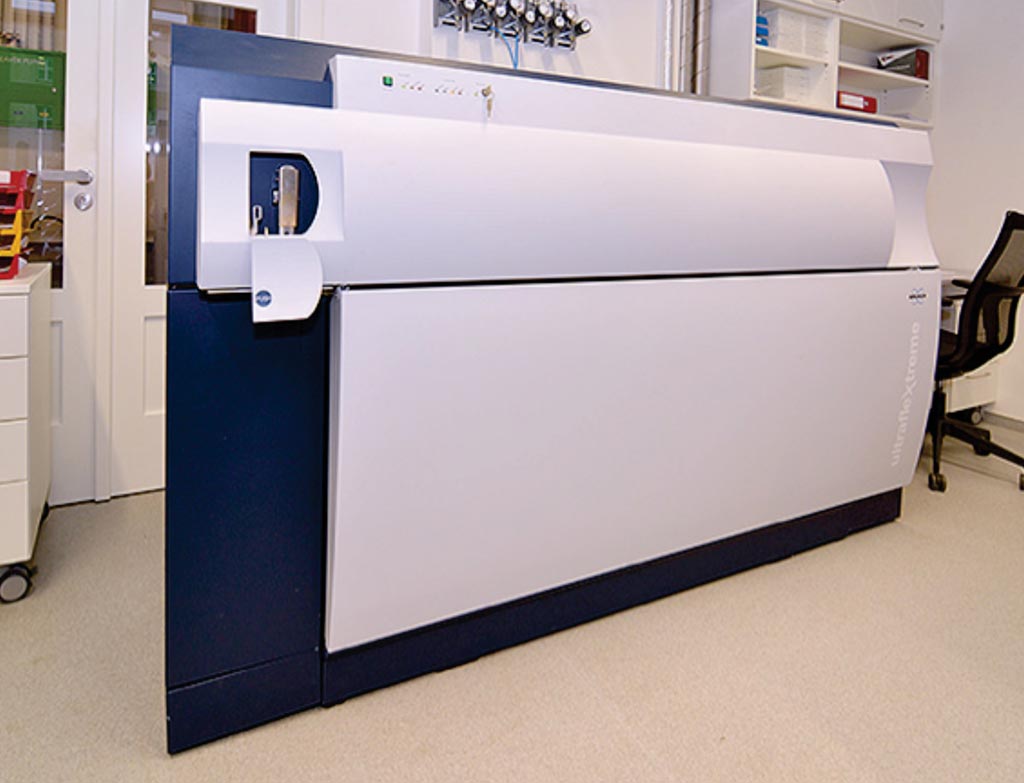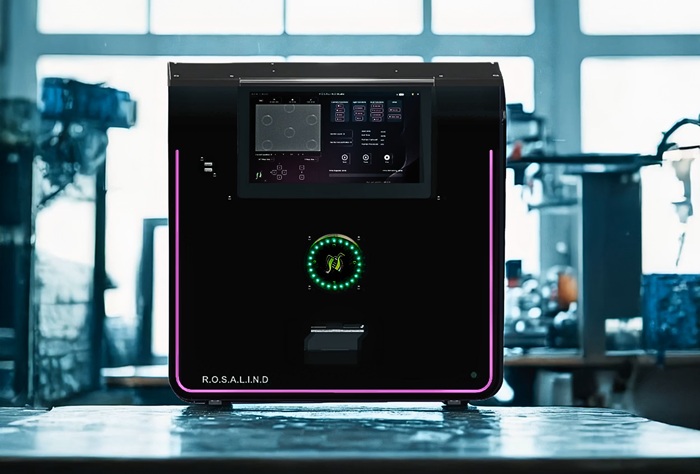MALDI-TOF MS Identifies Oomycete Causing Pythiosis
|
By LabMedica International staff writers Posted on 12 Dec 2018 |

Image: The UltrafleXtreme MALDI-TOF/TOF mass spectrometer (Photo courtesy of Bruker Daltonics).
Pythiosis is an invasive, difficult-to-treat, life-threatening infectious disease caused by Pythium insidiosum, a member of the unique group of fungus-like microorganisms called oomycetes. The disease has been increasingly reported worldwide.
In the past decade, the matrix-assisted laser desorption ionization–time of flight mass spectrometry (MALDI-TOF MS) has emerged as a novel and powerful diagnostic tool for facilitating the clinical identification of many pathogenic microorganisms, including bacteria and fungi.
Scientists at the Mahidol University (Bangkok, Thailand) isolated a total of 13 strains of P. insidiosum, isolated from eight humans and five animals with pythiosis, from different geographic locations. All organisms were maintained on Sabouraud dextrose agar at 25 °C. Several small portions of a colony of each organism were transferred to a 50-mL flask containing 10 mL Sabouraud dextrose broth, and incubated at 37 °C for one week, before harvesting fungal material for protein extraction.
Protein was extracted from harvested organisms and was spotted onto a clean ground steel target plate in 40 replicates (for generating a MALDI-TOF MS database of P. insidiosum) or five replicates (for assessing the MALDI-TOF MS for identification of P. insidiosum), air dried at room temperature before being processed. After the matrix solution was air dried at room temperature, the sample was promptly analyzed, using a Bruker ultrafleXtreme mass spectrometer. Genomic DNA (gDNA) templates were extracted from the organisms and subjected to single nucleotide polymorphism-based multiplex polymerase chain reaction (PCR).
The team reported that the MALDI-TOF MS accurately identified all 13 P. insidiosum strains tested, at the species level. Mass spectra of P. insidiosum did not match any other microorganisms, including fungi (i.e., Aspergillus species, Fusarium species, and fungal species of the class Zygomycetes), which have similar microscopic morphologies with this oomycete. MALDI-TOF MS- and rDNA sequence-based biotyping methods consistently classified P. insidiosum into three groups: Clade-I (American strains), II (Asian and Australian strains), and III (mostly Thai strains).
The authors concluded that MALDI-TOF MS has been successfully used for identification and biotyping of P. insidiosum. The obtained mass spectral database allows clinical microbiology laboratories, well equipped with a MALDI-TOF mass spectrometer, to conveniently identify P. insidiosum, without requiring any pathogen-specific reagents (i.e., antigen, antibody or primers). The study was published in the December 2018 issue of the International Journal of Infectious Diseases.
Related Links:
Mahidol University
In the past decade, the matrix-assisted laser desorption ionization–time of flight mass spectrometry (MALDI-TOF MS) has emerged as a novel and powerful diagnostic tool for facilitating the clinical identification of many pathogenic microorganisms, including bacteria and fungi.
Scientists at the Mahidol University (Bangkok, Thailand) isolated a total of 13 strains of P. insidiosum, isolated from eight humans and five animals with pythiosis, from different geographic locations. All organisms were maintained on Sabouraud dextrose agar at 25 °C. Several small portions of a colony of each organism were transferred to a 50-mL flask containing 10 mL Sabouraud dextrose broth, and incubated at 37 °C for one week, before harvesting fungal material for protein extraction.
Protein was extracted from harvested organisms and was spotted onto a clean ground steel target plate in 40 replicates (for generating a MALDI-TOF MS database of P. insidiosum) or five replicates (for assessing the MALDI-TOF MS for identification of P. insidiosum), air dried at room temperature before being processed. After the matrix solution was air dried at room temperature, the sample was promptly analyzed, using a Bruker ultrafleXtreme mass spectrometer. Genomic DNA (gDNA) templates were extracted from the organisms and subjected to single nucleotide polymorphism-based multiplex polymerase chain reaction (PCR).
The team reported that the MALDI-TOF MS accurately identified all 13 P. insidiosum strains tested, at the species level. Mass spectra of P. insidiosum did not match any other microorganisms, including fungi (i.e., Aspergillus species, Fusarium species, and fungal species of the class Zygomycetes), which have similar microscopic morphologies with this oomycete. MALDI-TOF MS- and rDNA sequence-based biotyping methods consistently classified P. insidiosum into three groups: Clade-I (American strains), II (Asian and Australian strains), and III (mostly Thai strains).
The authors concluded that MALDI-TOF MS has been successfully used for identification and biotyping of P. insidiosum. The obtained mass spectral database allows clinical microbiology laboratories, well equipped with a MALDI-TOF mass spectrometer, to conveniently identify P. insidiosum, without requiring any pathogen-specific reagents (i.e., antigen, antibody or primers). The study was published in the December 2018 issue of the International Journal of Infectious Diseases.
Related Links:
Mahidol University
Latest Molecular Diagnostics News
- World's First NGS-Based Diagnostic Platform Fully Automates Sample-To-Result Process Within Single Device
- Rapid Diagnostic Breakthrough Simultaneously Detects Resistance and Virulence in Klebsiella Pneumoniae
- DNA Detection Platform Enables Real-Time Molecular Detection
- STI Molecular Test Delivers Rapid POC Results for Treatment Guidance
- Blood Biomarker Improves Early Brain Injury Prognosis After Cardiac Arrest
- Biomarkers Could Identify Patients at High Risk of Severe AKI After Major Surgery
- CLIA Test Identifies Head and Neck Cancer Recurrence from Post-Surgical Lymphatic Fluid
- New 15-Minute Hepatitis C Test Paves Way for Same-Day Treatment
- Ovarian Cancer Assay Outperforms Traditional Tests in Early Detection
- Ultrasensitive Method Detects Low-Frequency Cancer Mutations
- Blood Test Enables Non-Invasive Endometriosis Detection
- New Blood Biomarkers Help Diagnose Pregnancy-Linked Liver Complication
- Simple Urine Test to Revolutionize Bladder Cancer Diagnosis and Treatment
- Blood Test to Enable Earlier and Simpler Detection of Liver Fibrosis
- Genetic Marker to Help Children with T-Cell Leukemia Avoid Unnecessary Chemotherapy
- Four-Gene Blood Test Rules Out Bacterial Lung Infection
Channels
Clinical Chemistry
view channel
Noninvasive Blood-Glucose Monitoring to Replace Finger Pricks for Diabetics
People with diabetes often need to measure their blood glucose multiple times a day, most commonly through finger-prick blood tests or implanted sensors. These methods can be painful, inconvenient, and... Read more
POC Breath Diagnostic System to Detect Pneumonia-Causing Pathogens
Pseudomonas aeruginosa is a major cause of hospital-acquired and ventilator-associated pneumonia, particularly in lung transplant recipients and patients with structural lung disease. Its ability to form... Read moreMolecular Diagnostics
view channel
World's First NGS-Based Diagnostic Platform Fully Automates Sample-To-Result Process Within Single Device
Rapid point-of-need diagnostics are of critical need, especially in the areas of infectious disease and cancer testing and monitoring. Now, a direct-from-specimen platform that performs genomic analysis... Read more
Rapid Diagnostic Breakthrough Simultaneously Detects Resistance and Virulence in Klebsiella Pneumoniae
Antibiotic resistance is a steadily escalating threat to global healthcare, making common infections harder to treat and increasing the risk of severe complications. One of the most concerning pathogens... Read moreHematology
view channel
MRD Tests Could Predict Survival in Leukemia Patients
Acute myeloid leukemia is an aggressive blood cancer that disrupts normal blood cell production and often relapses even after intensive treatment. Clinicians currently lack early, reliable markers to predict... Read more
Platelet Activity Blood Test in Middle Age Could Identify Early Alzheimer’s Risk
Early detection of Alzheimer’s disease remains one of the biggest unmet needs in neurology, particularly because the biological changes underlying the disorder begin decades before memory symptoms appear.... Read more
Microvesicles Measurement Could Detect Vascular Injury in Sickle Cell Disease Patients
Assessing disease severity in sickle cell disease (SCD) remains challenging, especially when trying to predict hemolysis, vascular injury, and risk of complications such as vaso-occlusive crises.... Read more
ADLM’s New Coagulation Testing Guidance to Improve Care for Patients on Blood Thinners
Direct oral anticoagulants (DOACs) are one of the most common types of blood thinners. Patients take them to prevent a host of complications that could arise from blood clotting, including stroke, deep... Read moreImmunology
view channel
Blood Test Could Identify Colon Cancer Patients to Benefit from NSAIDs
Colon cancer remains a major cause of cancer-related illness, with many patients facing relapse even after surgery and chemotherapy. Up to 40% of people with stage III disease experience recurrence, highlighting... Read moreBlood Test Could Detect Adverse Immunotherapy Effects
Immune checkpoint inhibitors have transformed cancer treatment, but they can also trigger serious immune-related adverse events that damage healthy organs and may become life-threatening if not detected early.... Read morePathology
view channel
AI Tool Simultaneously Identifies Genetic Mutations and Disease Type
Interpreting genetic test results remains a major challenge in modern medicine, particularly for rare and complex diseases. While existing tools can indicate whether a genetic mutation is harmful, they... Read more
Rapid Low-Cost Tests Can Prevent Child Deaths from Contaminated Medicinal Syrups
Medicinal syrups contaminated with toxic chemicals have caused the deaths of hundreds of children worldwide, exposing a critical gap in how these products are tested before reaching patients.... Read more
Tumor Signals in Saliva and Blood Enable Non-Invasive Monitoring of Head and Neck Cancer
Head and neck cancers are among the most aggressive malignancies worldwide, with nearly 900,000 new cases diagnosed each year. Monitoring these cancers for recurrence or relapse typically relies on tissue... Read moreTechnology
view channel
Diagnostic Chip Monitors Chemotherapy Effectiveness for Brain Cancer
Glioblastoma is one of the most aggressive and fatal brain cancers, with most patients surviving less than two years after diagnosis. Treatment is particularly challenging because the tumor infiltrates... Read more
Machine Learning Models Diagnose ALS Earlier Through Blood Biomarkers
Amyotrophic lateral sclerosis (ALS) is a rapidly progressive neurodegenerative disease that is notoriously difficult to diagnose in its early stages. Early symptoms often overlap with other neurological... Read moreIndustry
view channel
BD and Penn Institute Collaborate to Advance Immunotherapy through Flow Cytometry
BD (Becton, Dickinson and Company, Franklin Lakes, NJ, USA) has entered into a strategic collaboration with the Institute for Immunology and Immune Health (I3H, Philadelphia, PA, USA) at the University... Read more








 (3) (1).png)













